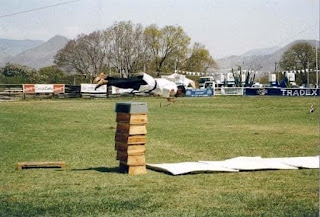The old forms like kūsankū, gojūshiho, sēsan, jitte, and many more, were developed through actual fighting, often in matches, but also in street situations in various cases, and they are ultimately related to the ancient Chinese military. In the same way, techniques in karate like those found in tuidi, are from actual fighting and are derived from the ancient Japanese military and Okinawan grappling called tigumi. Although we don’t practise in a militaristic way in my school, discipline is a quality of the military, and our methods are related to the military. This is why it is important to preserve the old ways; not for the sake of it, but because they were developed from war, hardship, and actual fighting in matches and in the street. That makes the techniques and methods genuinely useful, as opposed to many, though not all, modern ideas that are often either not based on actual fighting, or are based on competitive and prize matches, meaning that they have removed the element of the real danger of losing your life. Without that, the techniques may be good to a point, but they will lack what is required to fight effectively in a life-or-death street-fight that happens at random, as they do. Just like the old days, people with military experience who have fought in war are good modern examples of people with actual fighting experience, as well as those who have had to defend themselves in the street.
Many people with martial arts schools these days have experience of fighting in competitions, and know how to win with strategy and tactics. These teachings can be useful, still, for the street, but, again, I would argue that it’s dangerous to rely on techniques not aimed at life-or-death conflict. Actual fighting is different and requires something more. People such as police officers would appreciate this point. When I was a teenager, I competed for a couple of years before realising that, for me, there was no point in fighting for trophies. The only other competition I entered after the age of 17 was when I was 20, and it was aimed at being more of a demonstration for the school I was a member of, and assistant instructor with, at the time. Following this, I left that side of martial arts behind, for good, although not forgetting the tactics I had been taught.
For my school, Matsuyoshi-juku Shōtō-ha Shōrin-ryū Karate Kenpō to Kobujutsu, my real fighting experience is from actual situations. The reason I want to share this is because I feel that it is necessary for a martial arts teacher to understand actual fighting, and therefore to be able to provide support for why they have their own school in which there teach, as the basis, fighting. From the age of 18, aside from a couple of incidents in which I was attacked during high school, first when I was 11, and then at 15 years old, I have experienced many different situations, against individuals and multiple opponents. I’ve had to defend, grapple, avoid being tripped, strategically escape, purposefully reposition the direction of the Sun, simply stand ready to react if necessary, release from a grip and create distance, and more. What I’ve learnt from these experiences, coupled with having studied strategy and tactics, is not limited to proving certain techniques from kata such as naihanchi and kūsankū to be evidently useful, but is, additionally and generally, that distance and timing are critical, along with speed, accuracy, agility, a strong stance, the effective application of the principles of hard and soft, and, even in the street, strategy and tactics. People should always avoid fighting at all reasonable costs. Although, it cannot be denied that actual experience in anything always enables real learning and understanding. In all of the actual situations I’ve experienced so far in my adult life, I was the defender, and in all cases I avoided being hit, and, when actually making contact, I didn’t use excessive force, as I didn’t need to. You only need to apply the amount of force necessary, minimising to be efficient. Stamina is very important in actual fighting, and a key aspect of retaining stamina is to simply be efficient, although physical fitness and correctly regulated breathing are highly necessary as well. In my opinion, real martial arts, whether old-style or newer, should be mainly concerned with how to effectively defend in random situations of life-or-death. Hence, my philosophy in my school is to be mainly concerned with life-or-death situations, and how to effectively and efficiently defend yourself, also using strategy and tactics, as a last resort.
S. R. Marshall
Godan, Shōrin-ryū Karate























![Yoshitaka Funakoshi jump, probably in kusanku [sho] (kanku [sho])](https://blogger.googleusercontent.com/img/b/R29vZ2xl/AVvXsEje1wGAB1ZkSCft3_g90N4C3yw31f_Wa24-OZk0Xd8IhdSL19qZ6mtzjN8sbiFU2oep84WxzjeaBgSybEnEyJvT_Xz6jNJvOEugXET2-NCgB5drCe0q1xDWYtff71jFmwReauBPXZe_tw06srpVm3ruWj4_Y_4jdFG3aEgirP12btmfFD7otrumaxg6/w320-h232/IMG_6909.jpeg)





